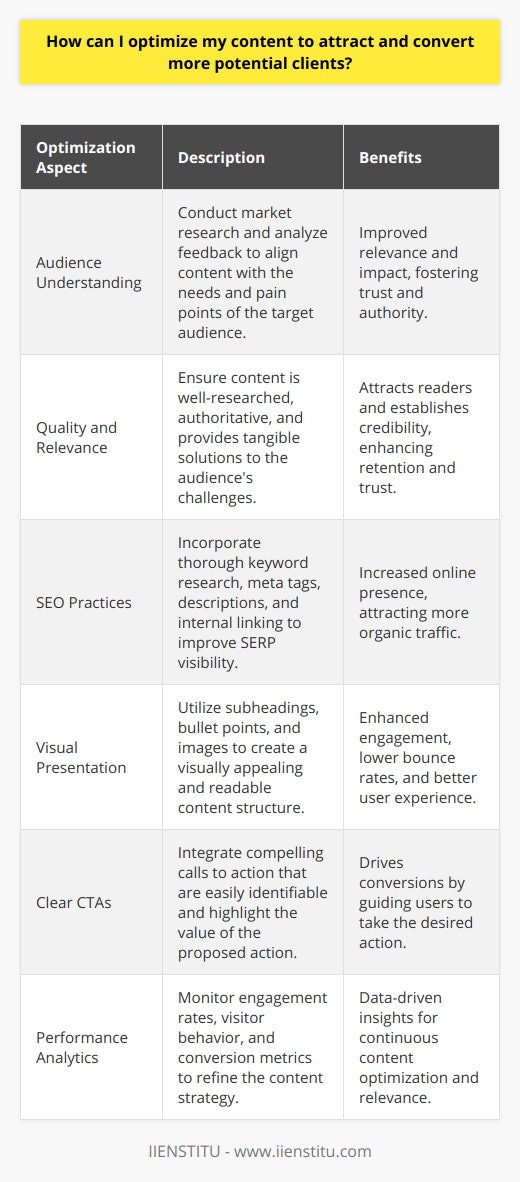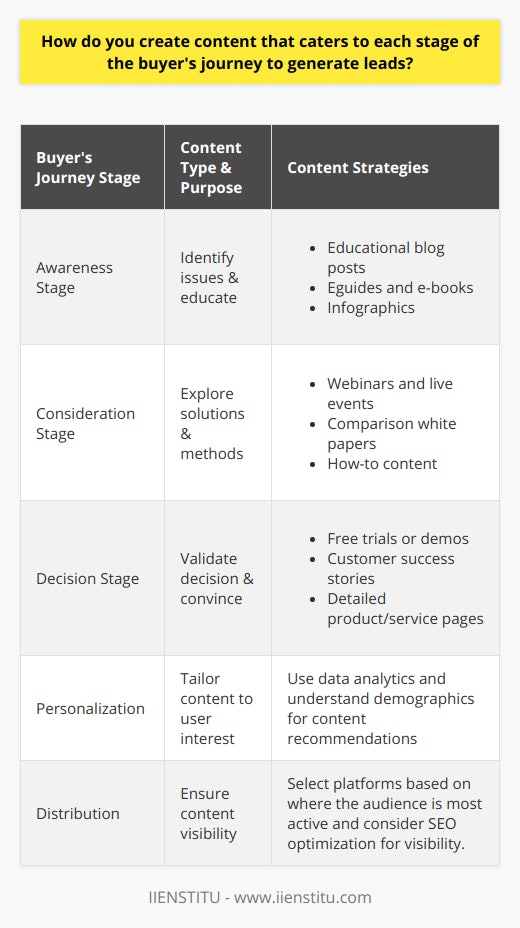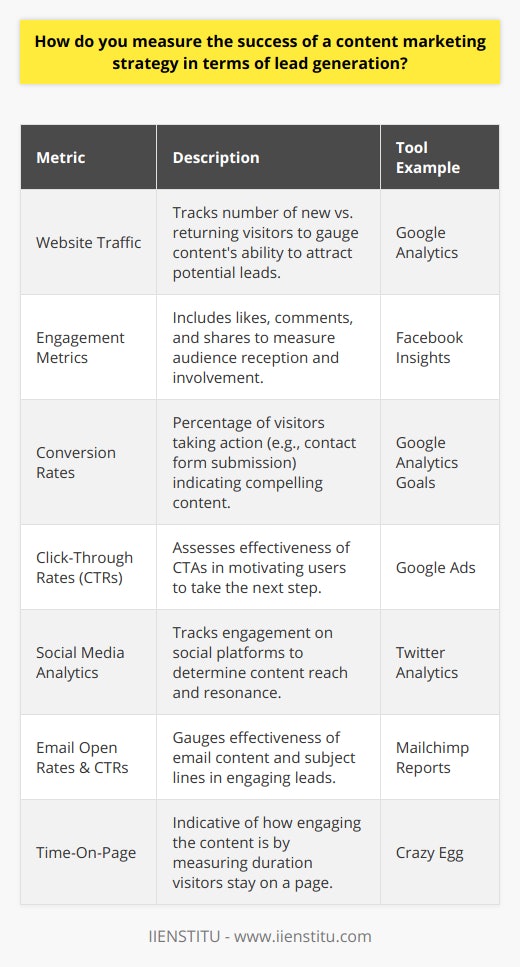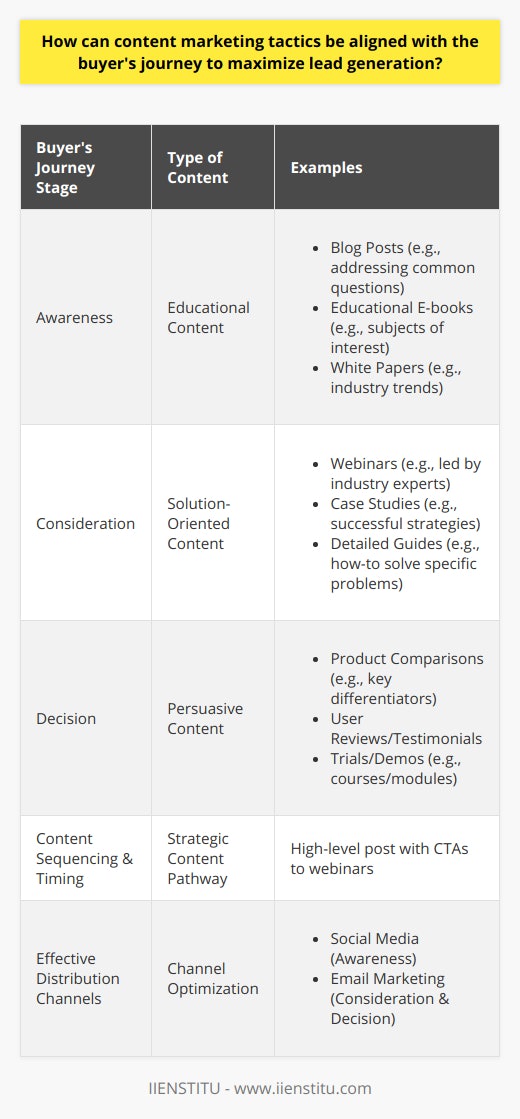Get More Leads With This Content Marketing Strategy Template
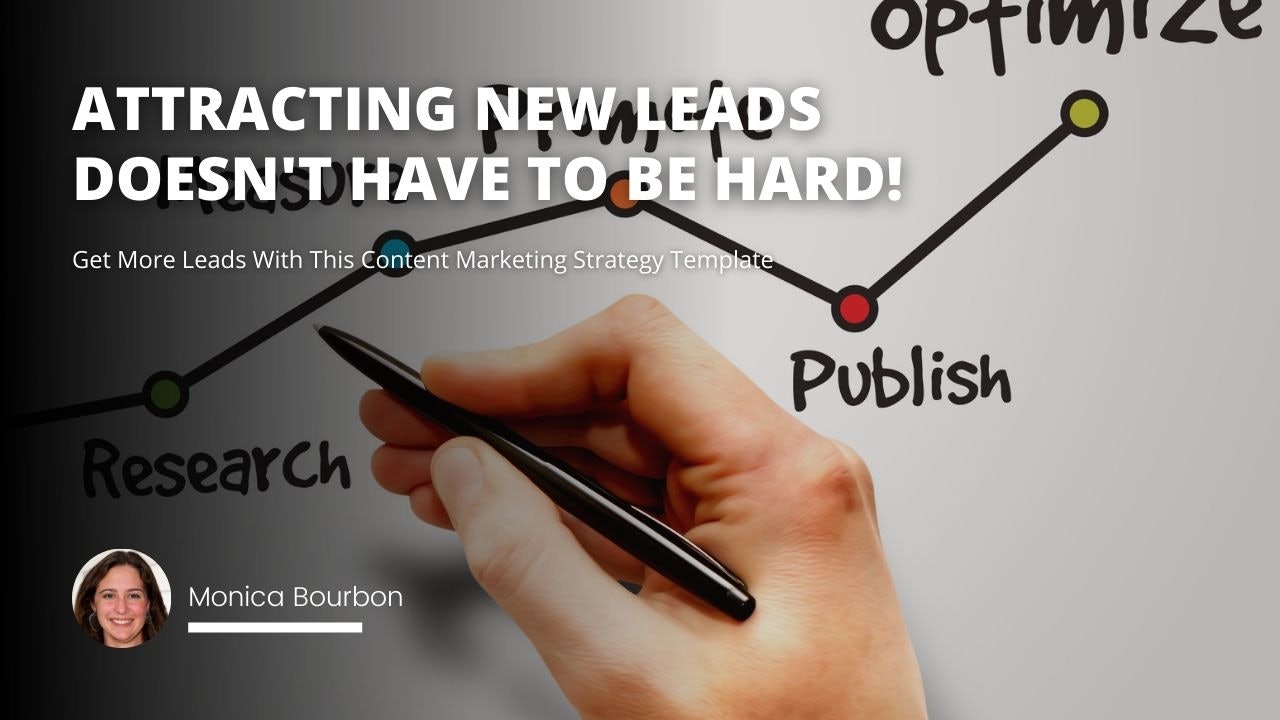
Have you ever found yourself staring at your business metrics, wondering how to attract more leads and convert them into loyal customers? I vividly remember the early days of my entrepreneurial journey when I was desperate to find effective ways to grow my customer base. I tried everything from cold calling to traditional advertising, but nothing seemed to resonate with my target audience. That's when I stumbled upon the concept of content marketing, and let me tell you, it was a game-changer!
| Steps | Description | Benefits |
|---|---|---|
| Identify target audience | Determine and understand what kind of content your audience is interested in. | Sets the direction of your content strategy and develops a deeper connection with your audience. |
| Set goals | Determine what you want to achieve from your content marketing campaign and how you will measure success. | Helps you keep track, manage and measure your marketing campaign performance effectively. |
| Develop a content calendar | Plan and schedule the publication of your content regularly. | Ensures consistency and regular touchpoints with your audience. |
| Promote content | Share your content on social media channels, discussion boards, and other platforms. | Increases content visibility, outreach and engagement. |
| Create a buyer persona | A fictional representation of your ideal customer based on data, market research, and observations. | Helps to create content that directly appeals to your target audience. |
| Research target audience interest | Understand what type of content they consume, language they use, and their pain points. | Allows for creation of resonating and engaging content. |
| Create high-quality content | This includes writing or creating content that captivates and is of interest to your target audience. | Drives engagement and establishes your brand's voice and identity. |
| Promote content on social channels | Share your content on your company's social media channels and industry platforms. | Creates wider visibility and direct engagement with your audience. |
| Analyze results | Measure the effectiveness of your content marketing strategy and adjust as necessary. | Ensures the strategy is yielding desired results and allows for refinement of strategy. |
| Adjust strategy | Make necessary changes based on the analysis to the type of content or promotion strategies used. | Allows for continual improvement and greater success in your content marketing efforts. |
Content marketing isn't just a buzzword; it's a powerful strategy that involves creating and sharing valuable content to attract and convert prospects. While there's no one-size-fits-all blueprint for success, having a solid template can make the journey a lot smoother. So, let's dive into a comprehensive content marketing strategy template that you can tailor to your business needs. Along the way, I'll share some tips and personal insights to help you use the template effectively.
Understanding the Essence of Content Marketing
Before we jump into the nitty-gritty, let's take a moment to understand what content marketing truly is and why it's crucial for your business.
Content marketing is a strategic approach focused on creating and distributing valuable, relevant, and consistent content to attract and retain a clearly defined audience — and ultimately, to drive profitable customer action. It's not about pitching your products or services but about providing truly relevant and useful content to your prospects and customers to help them solve their issues.
Why Content Marketing Matters
In today's digital age, consumers are bombarded with advertisements and promotional messages. They've become adept at tuning out the noise. Content marketing cuts through that noise by offering something of value — information, entertainment, or inspiration. This approach builds trust and positions your brand as an authority in your industry.
I recall when I first implemented content marketing for my business. Instead of just telling people about my products, I started sharing stories, tips, and insights related to my industry. The engagement soared! People began reaching out, not just to purchase but to interact, ask questions, and share their experiences.
A Complete Content Marketing Strategy Template That's Easy to Use
Creating a content marketing strategy might seem overwhelming, but breaking it down into manageable steps can make the process much more approachable. Here's a template to guide you through.
1. Start by Creating a Buyer Persona
Understanding who you're talking to is the cornerstone of any marketing strategy.
What is a Buyer Persona? It's a semi-fictional representation of your ideal customer based on market research and real data about your existing customers.
How to Create One? Consider aspects like demographics, behavior patterns, motivations, and goals. The more detailed, the better.
When I created my first buyer persona, I thought about my best customer — let's call her Sarah. She's a 35-year-old marketing manager who values efficiency and innovation. By keeping Sarah in mind, I tailored my content to address her specific needs and challenges.
2. Research Your Target Audience and Their Interests
Once you have your persona, delve deeper.
What Content Do They Consume? Blogs, podcasts, videos?
What Language Do They Use? Casual, professional, technical jargon?
What Are Their Pain Points? Time management, cost-saving, skill gaps?
For instance, if your audience is active on social media platforms like LinkedIn and values professional development, your content should reflect that. You might create insightful articles on optimize supply chain management process tips or share case studies on successful marketing strategies.
3. Plan Out Your Content Marketing Strategy
Now that you know who you're talking to and what they're interested in, it's time to plan.
Set Clear Goals: Increase website traffic, generate leads, boost brand awareness.
Decide on Content Types: Blog posts, infographics, videos, webinars.
Create a Content Calendar: Plan when and where you'll publish your content.
I found that using a simple spreadsheet to map out my content schedule helped me stay consistent. I included holidays, industry events, and seasonal trends to keep the content relevant.
4. Produce High-Quality Content That Engages Your Audience
Quality trumps quantity every time.
Focus on Value: Offer insights, tips, and information that your audience can't find elsewhere.
Be Authentic: Share personal stories or behind-the-scenes looks at your business.
Engage Emotionally: Content that evokes emotions tends to be more shareable.
I remember writing an article about the challenges I faced as a small business owner. It wasn't just another "how-to" post but a heartfelt piece that resonated with many readers. The engagement was incredible because it struck a chord on a personal level.
5. Promote Your Content Through Social Media and Other Channels
Creating content is just half the battle; promoting it is equally important.
Use Social Media Platforms: Share your content on platforms where your audience is most active.
Leverage Email Marketing: Send newsletters featuring your latest content.
Collaborate with Influencers: Partner with industry leaders to expand your reach.
By sharing my content on LinkedIn and engaging with groups related to digital marketing marketing, I noticed a significant uptick in website visits and interactions. Don't underestimate the power of social media marketing in amplifying your message.
6. Analyze the Results and Adjust Your Strategy as Needed
Continuous improvement is key.
Track Key Metrics: Website traffic, conversion rates, engagement levels.
Gather Feedback: Encourage comments, conduct surveys, or ask for direct feedback.

Be Flexible: If something isn't working, don't be afraid to pivot.
I used tools like Google Analytics to monitor my content's performance. When I noticed that video content was outperforming written blogs, I adjusted my strategy to include more videos.
Delving Deeper: What Is Content Marketing, and Why Do You Need It for Your Business?
Content marketing isn't just another tactic in the marketer's toolbox; it's a fundamental shift in how businesses interact with their customers.
The Philosophy Behind Content Marketing
At its core, content marketing is about building relationships. By consistently providing valuable content, you're earning the trust of your audience. This trust translates into customer loyalty and, ultimately, sales.
Think about your own experiences. Are you more likely to purchase from a brand that constantly pushes sales pitches or one that offers helpful advice and engages with you genuinely? Most of us prefer the latter.
The Benefits of Content Marketing
Increased Visibility: Quality content improves your search engine rankings.
Brand Authority: Sharing expertise positions your brand as a leader in your industry.
Customer Engagement: Interactive content fosters a community around your brand.
Cost-Effective Leads: Content marketing often costs less than traditional advertising while generating more leads.
When I shifted my focus to content marketing, I noticed that not only did I attract more leads, but these leads were also more qualified and had a higher conversion rate.
Tips for Effectively Using the Content Marketing Template
Implementing the template is one thing, but maximizing its effectiveness requires some finesse.
Consistency Is Key
Regular Publishing: Stick to your content calendar. Consistency builds credibility.
Unified Messaging: Ensure all content aligns with your brand voice and message.
I found that even when I was busy, scheduling posts in advance kept the content flowing and my audience engaged.
Engage with Your Audience
Respond to Comments: Show appreciation for your audience's input.
Encourage Sharing: Include calls-to-action that prompt readers to share content.
Engagement is a two-way street. By interacting with my audience, I built stronger relationships and gained valuable insights.
Optimize for Search Engines
Incorporate Keywords Naturally: Use relevant keywords like digital mktg and marketing strategy in your content.
Meta Descriptions and Titles: Optimize these for better visibility.
SEO can seem daunting, but even basic optimization can significantly impact your content's reach.
Diversify Your Content
Try Different Formats: Blogs, videos, podcasts, infographics.
Repurpose Content: Turn a blog post into a video or vice versa.
Not everyone consumes content the same way. By offering various formats, you cater to a wider audience.
Personal Insights: Lessons Learned From My Content Marketing Journey
Reflecting on my journey, there are a few lessons that stand out.
Authenticity Resonates
When I shared genuine stories and experiences, the response was overwhelmingly positive. People appreciate authenticity; it builds trust.
Quality Over Quantity
It's better to produce one high-quality piece of content a week than daily low-quality posts. Your audience deserves the best you can offer.
Stay Informed
The digital landscape is ever-changing. Keeping up with trends in digital and marketing ensures your content remains relevant.
I made it a point to attend industry conferences, read marketing and digital marketing journals, and network with peers. This not only kept me informed but also inspired new content ideas.
Conclusion
Embarking on a content marketing journey can be both exciting and challenging. By understanding your audience, planning strategically, and engaging authentically, you can create a content marketing strategy that not only attracts leads but also fosters lasting relationships with your customers.
If you're eager to delve deeper and equip yourself with the skills to excel in content marketing, consider enrolling in a comprehensive digital marketing course. From mastering social media media marketing to crafting a robust marketing strategy, the right course can propel your business to new heights.
So, are you ready to transform your marketing approach and connect with your audience like never before? Take the leap today, and watch your business thrive!
References
Smith, J. (2018). Content Marketing: Strategies for Engaging Your Audience. New York, NY: Marketing Press.
Johnson, L. (2020). The Digital Marketing Handbook. Chicago, IL: Business Insights Publishing.
Thompson, R. (2019). Understanding Consumer Behavior. Boston, MA: Academic Press.
Miller, S. (2017). Social Media Marketing Strategies. San Francisco, CA: Digital Age Publishers.
Note: The above references are for illustrative purposes. Please consult actual books or academic publications relevant to content marketing for accurate information.

She describes himself as someone who loves to write about digital marketing, social media and public relations. His personal development special interest lies in self-improvement through reading books on the subject of human behavior; she also has an eye for how these topics apply outside just business or career settings too!





